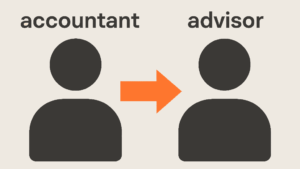
What’s Keeping Accountants Stuck in Compliance, Why Clients Want More and How Advisory Opens the Way Forward
“If you always do what you’ve always done, you’ll always get what you’ve always got.”
– Henry Ford
Let’s be honest: We love compliance because it feels safe.
It’s where most accountants cut their teeth. It’s tangible, transactional, and comes with clear rules. Lodgements, reconciliations and reporting each have a system and a finish line. You know what’s expected, and your clients do too. It’s a box you can confidently tick.
But while compliance has remained familiar, your clients’ needs haven’t.
Today’s business owners are more informed, more ambitious, and more overwhelmed than ever before. They’re facing challenges that can’t be solved with last year’s tax return. They want help with decisions, not just deductions.
And yet, many firms remain locked in a compliance-only mindset, not because it’s what they or their clients need, but because it’s what feels comfortable.
The Reality: Comfort No Longer Equals Security
One of the biggest misconceptions in the industry today is that staying in the compliance comfort zone protects your firm from risk. But in a market increasingly shaped by disruption, comfort is no longer security, it’s exposure.
Automation continues to accelerate. AI can now produce financial reports, summaries, and even forecasting insights in seconds. Cloud platforms and integrated apps now handle the technical grunt work that once justified hours of human effort. At the same time, offshore providers battle to undercut on price and speed.
In this new landscape, the traditional compliance model is being quietly, but steadily, commoditised. Clients can (and do) shop around. Software is fast, cheap, and always improving. That ‘safe’ stream of repeat work? It’s no longer as safe as it seems.
Here’s the challenge: When the way we add value starts to shift, it’s tempting to focus harder on the work we know best. Familiar workflows, reliable processes, and clear deliverables feel like a safe haven. In the face of disruption, it can be all too easy to respond by doubling down on compliance, aiming to do it faster, cheaper, and more efficiently.
While there’s still strength in that dedication, it comes at a cost. By holding tight to the familiar, we risk overlooking what our clients are increasingly asking for: deeper conversations, proactive planning, strategic guidance, and support that extends beyond the balance sheet.
What Clients Really Need, But Aren’t Saying Out Loud
Your clients aren’t just dealing with numbers, they’re dealing with pressure. Operational complexity. Rising costs. Tech that’s outpacing their processes. Teams they’re struggling to lead. Decisions they’re expected to make without a playbook.
They’re not just looking for someone to file their returns. Of course they want that, it’s part of the deal. But what they need is someone who helps them think clearly, stay steady and make decisions that move their business forward.
They don’t just need compliance. They need clarity, context, and confidence. And that’s exactly where your greatest value lies.
That’s Where Business Advisory Comes in, and it’s No Longer Optional
Advisory isn’t fluff. It’s not a trend. And it’s not a promise you make, but a practice you and your firm deliver.
It’s a deliberate, structured response to what your clients are asking for, even if they don’t always have the words for it. Advisory is about turning technical knowledge into strategic conversations. Helping clients see what’s possible. Aligning your insight with their goals, both personal and professional.
And no, this doesn’t mean abandoning everything you’ve built your career or your firm on. It’s about building on that and creating additional value for clients who already trust you.
You know their numbers. You’ve seen under the hood of their business. You’ve earned their confidence.
Advisory is where that knowledge becomes action, helping clients see clearly, plan wisely, and make progress where it counts. You may already be giving valuable advice, just without structure, intention, or return. Advisory simply gives it shape, value, and purpose.
Stepping into advisory isn’t just smart. It’s essential. Yes, it’s natural to feel unsure about making the shift. But that hesitation doesn’t mean you’re not ready. It means you care about doing it well. Still, even with that intent, it’s normal to feel resistance. And most of it comes down to a few common (and completely valid) concerns.
Why Accountants Hesitate Over Advisory
Even when accountants and firms do recognise the opportunity that advisory presents, many choose to remain in compliance. It’s not for the sake of resistance, but rather because they carry valid concerns that stem from their training, mindset and experience.
Here’s what typically holds them back, and how each barrier can be addressed with the right mindset, tools and support:
1. It feels too ambiguous:
However, ambiguity doesn’t have to mean chaos. With the right frameworks in place, advisory can be just as structured and repeatable as any compliance process.
2. It challenges identity:
Many accountants have built their careers and firms on technical expertise and problem solving. Advisory asks for a different strength: one that’s less about having all the answers, and more about creating and leading proactive conversations.
The shift may feel uncomfortable, but stepping into a more strategic role doesn’t dilute your credibility, it deepens it.
3. It demands new skills
Advisory conversations draw on soft skills like deep listening, strategic questioning, and emotional intelligence as you help clients navigate or define their goals and next steps.
These skills might feel unfamiliar but are completely learnable. Advisory isn’t about being overly charismatic; it’s about using curiosity and insight to guide better thinking. With the right tools and intent, these are skills every accountant can build up over time.
From Compliance to Connection Without Hesitation
Here’s the good news: If hesitation isn’t a factor, you’re closer to meeting client needs with advisory than you think.
Every time you explain a set of complex financials in plain English, you’re educating.
Every time you highlight a risk or trend to a client, you’re guiding.
Every time you suggest an improvement to a client’s business, you’re advising.
This shift doesn’t require you to become a different kind of accountant or start a new department right away. It simply asks that you take what you already do informally and give it structure, language, and intent.
By formalising your insight, you can begin to offer dedicated sessions, clear frameworks and packaged support that puts deep, future-minded value right in the hands of your clients.
Lead Early, Win Big
Accountants and firms that are actively developing their advisory capabilities aren’t just keeping up, they’re pulling ahead. Advisory opens up new revenue opportunities, not by doing more, but by doing what matters more. It helps firms stand out for their thinking, not just their pricing.
It also opens the door to creating a firm culture that attracts professionals who want purposeful, forward-thinking work and gives accountants the chance to build stronger client relationships and have deeper impact.
Most importantly, it helps build firms that are more anchored in long-term value and less dependent on volume to succeed.
It’s Time to Step into What’s Next
Advisory isn’t a departure from what you know, it’s an evolution of it. The greatest opportunity now lies in strategic advice, not just compliance, both for your clients and your future. The accountants and firms that thrive from here won’t be the ones who double down on the familiar, but the ones who respond to the change on our doorstep and build advisory into the way they lead, support and grow.
Remember, you don’t need to reinvent yourself. You already have what it takes to escape the compliance comfort zone. This isn’t a leap into the unknown. It’s a deliberate step into a more meaningful, more impactful version of the work you already do.



